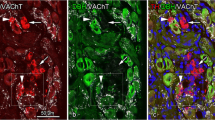Abstract
Injection of the retrograde neuronal tracer True blue into the anterior-lateral part of the nasal mucosa of rats labeled nerve cell bodies in the superior cervical ganglion, the sphenopalatine ganglion, the otic ganglion and the trigeminal ganglion on the ipsilateral side. In the superior cervical ganglion, the sphenopalatine ganglion and the trigeminal ganglion on the contralateral side, very few nerve cell bodies were labeled, indicating that these ganglia provide minor contributions only. The number of labeled cell bodies indicates that the superior cervical ganglion, the sphenopalatine ganglion and the trigeminal ganglion contribute most to the innervation of the nose, while the contribution from the otic ganglion is minor. Cell bodies in the superior cervical ganglion harbored noradrenaline (NA) or NA/neuropeptide Y (NPY); in the sphenopalatine ganglion vasoactive intestinal peptide (VIP) or VIP/NPY; in the otic ganglion VIP, VIP/NPY or VIP/substance P (SP) and in the trigeminal ganglion calcitonin gene-related peptide (CGRP) or CGRP/SP. The results from denervations and tracer experiments suggest that all NA-containing and the majority of NPY-containing fibers in the nasal mucosa are derived from the superior cervical ganglion (sympathetic nerve supply). VIP- and VIP/NPY-containing fibers originate from the sphenopalatine and otic ganglia (parasympathetic nerve supply). Nerve fibers containing CGRP and CGRP/SP emanate from the trigeminal ganglion (sensory nerve supply).
Similar content being viewed by others
References
Änggård A (1974) The effect of parasympathetic nerve stimulation on the microcirculation and secretion in the nasal mucosa of the cat. Acta Otolaryngol 78:98–105
Anton F, Peppel P (1991) Central projections of trigeminal primary afferents innervating the nasal mucosa: a horseradish study in the rat. Neuroscience 41:617–628
Azuma E, Asakura K, Kataura A (1982) Histochemical demonstration of peripheral autonomic innervation in canine nasal mucosa by retrograde axonal transport of horseradish peroxidase. Acta Otolaryngol 93:139–146
Coons AH, Leduc EH, Connolly JM (1955) Studies on antibody production. 1. A method for the histochemical demonstration of specific antibody and its application to a study of the hyper-immune rabbit. J Exp Med 102:49–60
Dahlström A, Fuxe K (1965) The adrenergic innervation of the nasal mucosa of certain mammals. Acta Otolaryngol (Stockh) 59:65–72
Eccles R, Wilson H (1973) The parasympathetic secretory nerves of the nose of the cat. J Physiol 230:213–220
Furness JB, Costa M, Keast JR (1984) Choline acetyltransferase- and peptide immunoreactivity of submucous neurons in the small intestine of the guinea pig. Cell Tissue Res 237:329–336
Grunditz T, Håkanson R, Rerup C, Sundler F, Uddman R (1984) Neuropeptide Y in the thyroid gland: neuronal localization and enhancement of stimulated thyroid hormone secretion. Endocrinology 115:1537–1542
Grunditz T, Håkanson R, Hedge G, Rerup C, Sundler F, Uddman R (1986) Peptide histidine isoleucine amide stimulates thyroid hormone secretion and coexists with vasoactive intestinal polypeptide in intrathyroid nerve fibers from laryngeal ganglia. Endocrinology 118:783–790
Grunditz T, Håkanson R, Sundler F, Uddman R (1988a) Neuronal pathways to the rat thyroid revealed by retrograde tracing and immunocytochemistry. Neuroscience 24:321–335
Grunditz T, Ekman R, Håkanson R, Sundler F, Uddman R (1988b) Neuropeptide Y and vasoactive intestinal peptide coexist in rat thyroid nerve fibers emanating from the thyroid ganglion. Regul Pept 23:193–208
Ishii T (1970) The cholinergic innervation of the human nasal mucosa. Pract Otol Rhinol Laryngol 32:153–158
Lacroix JS, Änggård A, Hökfelt T, O'Hare MMT, Fahrenkrug J, Lundberg JM (1990) Neuropeptide Y: presence in sympathetic and parasympathetic innervation of the nasal mucosa. Cell Tissue Res 259:119–128
Leblanc G, Landis S (1988) Target specificity of neuropeptide Y-immunoreactive cranial parasympathetic neurons. J Neurosci 8(1): 146–155
Lundblad L, Änggård A, Lundberg JM (1983) Effects of antidromic trigeminal nerve stimulation in relation to parasympathetic vasodilation in cat nasal mucosa. Acta Physiol Scand119:7–13
Luts A, Sundler F (1989) Peptide-containing nerve fibers in the respiratory tract of the ferret. Cell Tissue Res 258:259–267
Malm L (1973) Stimulation of sympathetic nerve fibers to the nose in cats. Acta Otolaryngol 75:519–526
Rush RA, Geffen LB (1981) Dopamine-beta-hydroxylase in health and disease. CRC Crit Rev Clin Lab Sci 12:241–277
Shipley MT (1985) Transport of molecules from nose to brain: Transneuronal anterograde and retrograde labeling in the rat olfactory system by wheat germ agglutinin-horseradish peroxidase applied to the nasal epithelium. Brain Res Bull 15:129–142
Skagerberg G, Björklund A, Lundvall O (1985) Further studies on the use of True Blue as a retrograde fluorescent tracer in combination with monoamine histochemistry. J Neurosci Methods 14:25–40
Stewart W (1985) Labelling of olfactory bulb glomeruli following horseradish peroxidase lavage of the nasal cavity. Brain Res 347:200–203
Stjärne P, Lundblad L, Änggård A, Hökfelt T, Lundberg JM (1989) Tachykinins and calcitonin gene-related peptide: coexistence in sensory nerves of the nasal mucosa and effects on blood flow. Cell Tissue Res 256:439–446
Sundler F, Brodin E, Ekblad E, Håkanson R, Uddman R (1985) Sensory nerve fibers: distribution of substance P, neurokinin A and calcitonin gene-related peptide. In: Håkanson R, Sundler F (eds) Tachykinin antagonists. Elsevier, Amsterdam, pp 3–14
Sundler F, Ekblad E, Grunditz T, Håkanson R Luts A, Uddman R (1989) NPY in peripheral non-adrenergic neurons. In: Mutt V et al. (ed) Neuropeptide Y. Raven Press, New York, pp 93–102
Uddman R, Alumets J, Densert O, Håkanson R, Sundler F (1978) Occurrence and distribution of VIP nerves in the nasal mucosa and tracheobronchial wall. Acta Otolaryngol (Stockh) 86:443–448
Uddman R, Malm L, Sundler F (1981) Peptide-containing nerves in the nasal mucosa. Rhinology 19:75–79
Author information
Authors and Affiliations
Rights and permissions
About this article
Cite this article
Grunditz, T., Uddman, R. & Sundler, F. Origin and peptide content of nerve fibers in the nasal mucosa of rats. Anat Embryol 189, 327–337 (1994). https://doi.org/10.1007/BF00190589
Accepted:
Issue Date:
DOI: https://doi.org/10.1007/BF00190589




